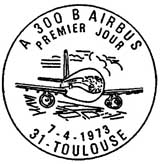TIMBRES DE FRANCE
Ex : 50 c
Ex : 456
Ex : Appel du 18 juin
Ex : 1900
Ex : Femme
mini 4 lettres
Création du site : Juillet 2005
Nombre de visiteurs : 34.303.761
Nombre de pages : 112.993.798
Dernière mise à jour 04-04-2025
Nombre de visiteurs : 34.303.761
Nombre de pages : 112.993.798
Dernière mise à jour 04-04-2025
Cette bannière est une publicité le site n'a aucune boutique de vente
Les informations sur ce timbre ont été mises à jour le : 25/10/2024

A300B Airbus
Timbre : Courant / moderne
Voir tous les timbres courants de l'année 1973
Listage des timbres de l'année 1973
Cachet premier jour


Premier jour : Oblitération 1er jour à Toulouse le 7 avril 1973
Vente générale : 9 avril 1973
Retrait de la vente : 8 février 1974
Valeur faciale : 3 f
Graveur : Pierre Gandon
Dessinateur : Paul Lengellé
Dentelure : Dentelé 13
Couleur : noir et bleu clair
Mode d'impression : Taille douce
Format du timbre : 40 x 26 mm ( image 36 x 21,45 mm bords externes des filets)
Quantité émis : 8.050.000
Présentation : Feuille de 50 timbres
Catalogue Yvert et Tellier France : N° 1751
Catalogue Spink / Maury France : N° 1751
Catalogue Michel : N° FR 1825
Catalogue Scott : N° FR 1365
Valeur marchande timbre neuf avec gomme intacte: 0,39 €
Valeur marchande timbre oblitéré : 0,25 €
La valeur marchande représente une valeur de base du timbre pour la vente ou l'échange
Thématique catégorie : Avions, bateaux, trains,voitures, motos, vélos
Informations sur le sujet du timbre
L'A300B est le premier gros-porteur biréacteur européen.
Nous sommes dans les années 1970. C'est l'époque des premiers chocs pétroliers et du ralentissement de la croissance économique. Dans ce contexte de pétrole cher et d'inflation, on se penche sur la rentabilité des avions de ligne. Le constructeur américain Boeing construit le premier gros porteur au monde, le B747. D'autres constructeurs américains suivent avec des appareils à trois réacteurs (McDonnell Douglas DC-10 et Lockheed Tristar). L'objectif est de transporter un grand nombre de passagers sur de longues distances, tout en réduisant les coûts opérationnels.
L'Europe court à nouveau le risque d'être distancé par les...lire la suite
The A300B is the first European twin-jet aircraft.
It’s the 1970s. This is the time of the first oil shocks and the slowdown in economic growth. In this context of expensive oil and inflation, the profitability of airliners is being examined. The US manufacturer Boeing is building the world’s first jumbo jet, the B747. Other US manufacturers follow with three-engine aircraft (McDonnell Douglas DC-10 and Lockheed Tristar). The aim is to transport a large number of passengers over long distances, while reducing operational costs.
Europe is once again running the risk of being outdistanced by the giants of American aerospace. In 1967, French, German and British ministers meet to discuss the future of aeronautical cooperation and the need for a large-capacity medium-haul aircraft. Roger Béteille is then in charge of this programme. He is now considered to be one of the founding fathers of the Airbus company.
On 29 May 1969 at the Paris Air Show, the signing of the Franco-German agreement marks the official launch of the A300. The aircraft is named because it is expected to carry up to 300 passengers. This figure will be reduced but the name will remain. The aircraft will be called the A300B to differentiate it from the original proposal.
The first flight of the A300B took place on 28 October 1972, piloted by Max Fischl and Bernard Ziegler (son of Henri Ziegler, president of Aérospatiale). The A300B is a modest commercial success in its early days, but more than 800 will be produced by 2007.
Source : various Internet documents including Wikipedia
